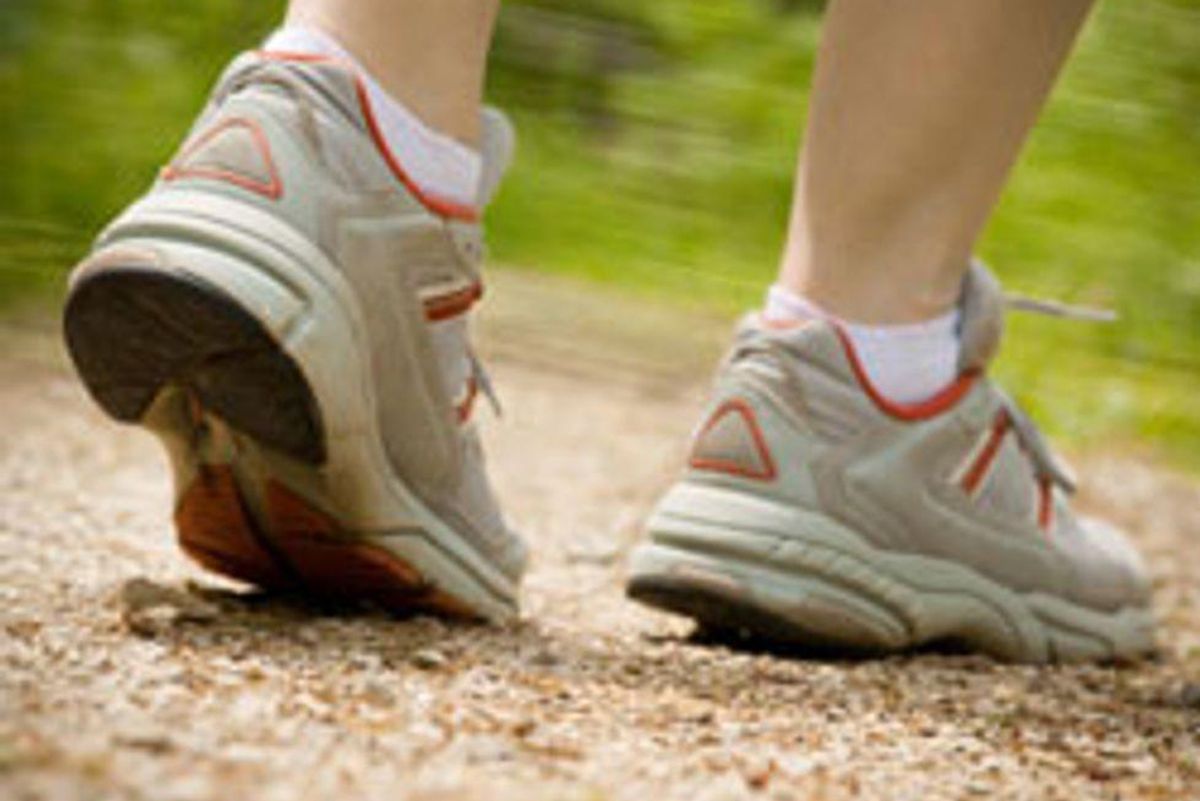For those of us who are fortunate enough to be able to walk, it's basic, right? Something we learn before our memories are formed. Like eating, chewing, talking. But just like eating, chewing and talking, there are ways to do it … and there are ways not to do it. Eat too fast, chew too little, and you will probably finish your food partially undigested and much sooner than you'd like. Talk too much, too little, or say the wrong thing, and you most likely will be a situation where you wish you could have taken it back or said more.
My most recent visit to the Golden Door Spa in Escondido, Calif. (if you're a tad jealous, I can't say I blame you; the place is very special!) brought me face-to-face with Carolyn Scott Kortge (pronounced core-chi), who was there enchanting the group with her popular mindful walking program, "Healing Walks—Healthy Paths."
Carolyn proves that not only is it possible to find and embrace something new in midlife, but that walking is a way to reach far beyond its obvious fitness advantages into its deeper meaning for life. Her philosophy is this: Every walk can be meaningful; a time for quiet reflection or a time for healing. It's more than just putting one foot in front of the other. It's an opportunity to reach inside yourself, get in touch with nature, lift your spirits or even speed recovery from an illness or setback.
I was fascinated with the circumstances that brought Carolyn from journalist to professional athlete and then back again to document it all in her two books, The Spirited Walkerand Healing Walks for Hard Times.
Q. You started a sport pretty late in life, when you were in your 40s. I find that both commendable and brave, since you were a self-proclaimed klutz. What inspired you?
A. While working as a journalist in Eugene, Ore., in 1989, I wrote about the preparations for the World Veterans Track Meet, which was being held in Eugene that year for masters' level athletes (over 35!) from around the world. Watching women train in my age group (40s and up)—strong, lean and competitive—triggered my own competitive spirit. In a year, I was on the starting line for my first track meet. My first meet didn't garner any medals or records, but it sealed my fascination with a new challenge—learning to work with my own body and incorporate my brain and spirit. I competed for five years, winning bronze and silver medals in national competition in USA Track and Field Associations National Masters' Championship meets.
I stopped competing when my 50-year-old body began to complain about the rigors of training. But I still racewalk for the pleasure and aerobic rewards of a vigorous walk.
Q. What was it about walking—especially about competition—that hooked you? Do you think it was the physical or mental benefit you got from it or perhaps a combination of both?
A. There was something about the "wholeness" effect that competition had for me. I had to learn to stop the self-doubt and second guessing that erupted when I wondered if I had gone out too slowly in a race to ever catch my competition, or if I had strength to finish the last two laps of a 12-lap 5-K race. At first, I had mini tantrums in the midst of meets—invisible eruptions that sent me swirling mentally when someone passed me or I felt fatigued. I had to learn to tell myself, "I am here. I am walking. I am here. I am breathing. Walking, breathing, walking, breathing.…"
Voila! Moments of wholeness. Eventually, I came to believe that what I had attributed initially to endorphins was equally a result of "wholeness"—that when mind and body and spirit work together toward a shared goal, the outcome is sense of wholeness and alignment that we don't often experience.
Here's a quote from The Spirited Walker that summarizes it:
"As the movement and rhythm of walking teamed up with awareness and intention, my workouts achieved a unity that embraced all of me. They drew me into active meditation. I became a 'spirited walker.'"
—Chapter I
Q. Many people find it difficult to get started on an exercise regime, especially if they've been sedentary. Or, they get easily bored or injured and abandon it altogether. Any advice for the novice walker?
A. In starting a walking program, I encourage frequency rather than distance. It's easier if we don't make huge demands upon ourselves. Make it a goal to walk six days a week, but let a 10-minute walk be OK if that's what you have time for. (Of course, if you have time for 30 minutes one day, take a longer walk.) Also, keeping a log really helps support commitment. So does making a walking date with a friend.
But bottom line for me is remembering that just 10 minutes of brisk walking can boost energy levels and moods for up to two hours. It supports the validity of short walks. Maybe you take two or three 10-minute walks a day when you really need some energy. I think that the benefits you feel from these 10-minute walks can be the best motivator to get you out for the next one, tomorrow and the next day.
Q. When I practiced walking with you at the Golden Door, I began to see things differently. I noticed nature and my senses much more intensely than I ever did on my previous walks around that very same path. It almost felt as if I was meditating, although I'm bad at meditating since I have trouble sitting still for long. Is walking the spirited way a form of moving meditation?
A. Absolutely! Spirited walking is active meditation—a fabulous form of meditation for those of us challenged by sitting still. When I was competing as a racewalker, I learned to use breath awareness to fuel my body for vigorous action. The simple repetition of "walking, breathing, walking, breathing" kept my focus on where I was right then. I also learned to use visual imagery, to see myself as fluid and graceful, rather than plodding and awkward. I'd been meditating as an athlete! That became the starting point for The Spirited Walker: Fitness Walking for Clarity, Balance, and Spiritual Connection.
Two years after that book came out, I was diagnosed with breast cancer. The meditative benefits of walking then offered a powerful retreat from the fear and physical discomfort of that diagnosis and treatment. For a few moments, I was able to get away from the terror, the anger, the confusion that raged inside me. Sometimes I focused on words: "One step forward at a time." Out of that experience and related teaching, I wrote Healing Walks for Hard Times, an eight-week program of guided walks that offer a path through troubled times in life.
Q. Winter is here for many of us, and it's too cold to walk outside. How can this type of walking be adapted to the indoors?
A. This is a familiar issue for me. I live in Eugene, Ore., where rain provides frequent temptation to skip a walk. In winter, I frequently exercise at an athletic club, using a treadmill or elliptical trainer to get my workout. Once a week I do deep-water jogging for cross-training. Often in the gym, I listen to my iPod, which has a couple of playlists for this purpose. These lists have music that offers enough of a beat to keep me moving, but no words. I want sound only. Then I can focus on a breathing pattern that creates a cadence of beats, steps and breath. "In, 2, 3, 4, out, 2,3,4." Keep this up for a couple of minutes and the mind settles into a quieter place. It's simple, even silly, but it works.
This Matters: Walking for wellness … not just fitness. Undoubtedly, a reachable goal.
Leaving a comment will automatically enter you to win a copy of Carolyn's newest book, Healing Walks for Hard Times. Two winners will be randomly chosen and notified by e-mail (so, please make sure to include your e-mail address) If you fail to respond within 48 hours of notification, you'll make someone else happy, because another winner will be chosen. Unlike some other giveaways, this one is worldwide, so those of you in the far reaches of the world can be part of the fun, too.
You may also want to read:
An Easy Way to Move More
Motivate Yourself Past Exercise Blocks







